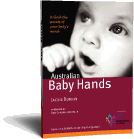Manners & Baby Sign Language
Did you know that as well as helping bridge the gap of communication for pre-verbal babies; baby sign language can also introduce the concept of manners.
Picture this, mind you are at a local coffee shop and your child begins to throw a temper tantrum. They want more food and start crying hysterically and causing a scene in the coffee shop. It is times like these that baby sign can be extremely beneficial in teaching your child manners. I have had many emails from parents explaining the above situation but the only difference is their child is signing “more” or “please” instead of crying. If their child does get annoyed, drug the parents can sign up close or from a distance words such as “stop” or “no” and also encourage their child to say “please” and “thank you” before and after they receive anything.
But as a parent where do you start with the abstract concept of manners?
Like any other sign it is all about consistency and patience. To start, I would introduce the signs for “please” and “thank you”. For every request that is made, add the sign and word “please” to the end of the sentence and once you have received what you have requested, you can sign and say the word “thank you”. As with any other sign, the more consistent you are, the sooner your baby will begin to understand that “please” is a sign that is used when I would like something and once I have received what I want, I sign “thank you”. Once your child gets experienced with these signs, you can start combining signs which will help with their language development. Examples include “more – please”, “finished – thank you” or “help – please”.
Other signs that will also help you in social situations are the following words/signs: “Stop”, “Sorry”, “Hello”, “Yes”, “No”, “Help” and “Goodbye”.
“Hello” and “Goodbye” can be introduced each time you meet someone or if someone calls to visit. When it is time for them to leave or for you to part company, you can then introduce the sign for “goodbye”. Again, be consistent and use these signs every time an opportunity presents itself.
“Yes” and “No” are great signs to be able which communicate to your child if they should or should not be doing something. Again, the more examples you give to your child, the easier it is for them to understand what it is you are trying to say.
Introducing the sign for “Stop” can be very powerful. Using this sign and the word together is really enforcing that you do not want your child to continue what they are doing or you do not want them to move from their current location. Again, be consistent when you do introduce any of these signs and try to get as many family members involved as possible.
There will be times where your child will get frustrated as they cannot do a task by themselves and introducing the sign for “help” can help alleviate this frustration. This sign can be introduced to demonstrate helping your child as well as demonstrating helping other people. This can be great to use with siblings, to get them to help each other.
Finally “sorry” is a great word to introduce to highlight that your child has done something naughty. Baby sign gives your children visual as well as verbal cues, to remind them to be kind to others.
Have fun introducing manners to your baby and start visualising calm coffee shop moments with no crying baby but instead a less frustrated happy signing child!
